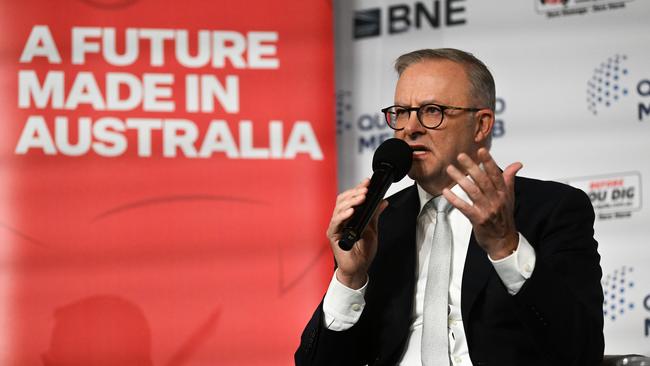Future Made in Australia Act puts country in global cleantech race
Anthony Albanese’s Future Made in Australia Act could be the foundation for our future as a zero-emissions trade and investment leader and global clean energy superpower.

Anthony Albanese last week announced the Future Made in Australia Act, designed to deliver a uniquely Australian Response to the US Inflation Reduction Act (IRA) – which is turbocharging renewables, cleantech and re-industrialisation in the US as it drives massive private capital investment – and comparable initiatives across other major economies.
The Act will bring together a co-ordinated and comprehensive package of new and existing decarbonisation initiatives to seize opportunities. It promises massive new investment, regional employment and net export opportunities, leveraging and value-adding our world-leading natural resources, both renewables and mining, as well as our expertise, geographic position in Asia and financial strengths.
It could be the foundation for our future as a zero-emissions trade and investment leader and global clean energy superpower, as we inevitably pivot from our historic dependence on carbon exports.
The Prime Minister says that in the forthcoming budget, the government will be bold and invest “at scale” to capitalise at speed on Australia’s comparative advantages and build sovereign capability in areas of national interest, including critical minerals and resources. Mr Albanese cited battery manufacturing as one of those opportunities.
This can’t come soon enough and makes sound economic sense – we are the world’s leading producer of lithium, which is essential to batteries, along with other critical minerals and metals, but we need to value-add to these onshore to extract the economic dividends for Australians. This Act builds on the government’s existing work on embracing clean energy, bolstering our skilled workforce, and creating new instrumentalities critical to the economic transition to zero emissions, such as the National Reconstruction Fund and the Net Zero Economy Authority.
This PM indicates the federal government will work on public-private collaboration, leveraging the firepower of our federal public balance sheet and budget to de-risk investments and ‘‘crowd-in’’ private capital, including our world-leading $3.6 trillion superannuation pool, to drive decarbonisation opportunities.
To capitalise on the advantages of our strongly export-oriented economy and our excellent relationships with our partners in an increasingly complex and dynamic global geopolitical context, the government’s Future Made in Australia is focused on collaborating with our Asian trade partners.
The government has acknowledged the need for better understanding and tools to determine how Australia encourages and develops an international green premium price signal for trade in decarbonised products. Carbon tariffs such as an Asian Carbon Border Adjustment Mechanism (CBAM) are a key longer-term geopolitical priority that will play to Australia’s advantages in renewables-powered processing and manufacturing – for example, our potential to dominate globally in green iron as the world’s No. 1 producer of iron ore.
Mr Albanese talks about a uniquely Australian response aligned to our economic characteristics: “27 per cent of our economic output depends on trade. And so do 1 in 4 Australian jobs.” Climate Energy Finance agrees entirely: this is the Asian century, and Australia is perfectly positioned as a key trading nation in the Asian region to leverage this with a strategic national interest-focused response that is bold and ambitious. The PM’s vision is to build on our existing strengths – and also look beyond them.
This is a point many old-school economists have so far failed to grasp: relying on traditional competitive advantage logic misses that the transition to net zero is a $US4-6 trillion annual investment opportunity globally for the next couple of decades, as both the International Energy Agency and BloombergNEF have asserted – and one in which every major economy has invested massive national interest public capital.
This changes the global energy and geopolitical landscape, profoundly and permanently.
Australia can’t rely on the traditional notion of free markets in international trade and competition. The $US1 trillion ($1.54 trillion) of public subsidies in the US IRA changes everything. China’s breathtaking scale and ambition of investment in manufacturing, technology, domestic deployments and exports in all zero-emissions industries of the future changes everything.
The Koreans, Japanese, EU, Indian and Canadian governments have all responded at scale to the massive, once in a century challenge and opportunity of global decarbonisation with huge strategic public funding programs.
We strongly support the federal government’s view that state intervention is the new competition. We can’t afford to sit it out. The Future Made In Australia Act puts Australia in the global race already under way. Public capital is the investment signal and de-risking that private capital needs to flood into domestic zero-emissions economic opportunities.
Many building blocks have been established over the last 18 months: the Net Zero Climate Act; the $15bn National Reconstruction Fund: the Safeguard Mechanism; the 32GW Capacity Investment Scheme; the $4bn Critical Minerals Facility; $1.9bn Repowering the Regions Fund; and the $20bn Rewiring the Nation Fund. What has been lacking in an overarching framework drawing together Australia’s patchwork of transition initiatives. Critically, the Net Zero Economy Authority will provide the co-ordination and industry sector roadmaps to ensure the Future Made in Australia strategy is coherently implemented.
We look forward to the government delivering a whole of government approach to the greatest single opportunity for our national economic development in living memory.
Blair Palese founded the Climate Capital Forum. Tim Buckley is a director of Climate Energy Finance.





To join the conversation, please log in. Don't have an account? Register
Join the conversation, you are commenting as Logout